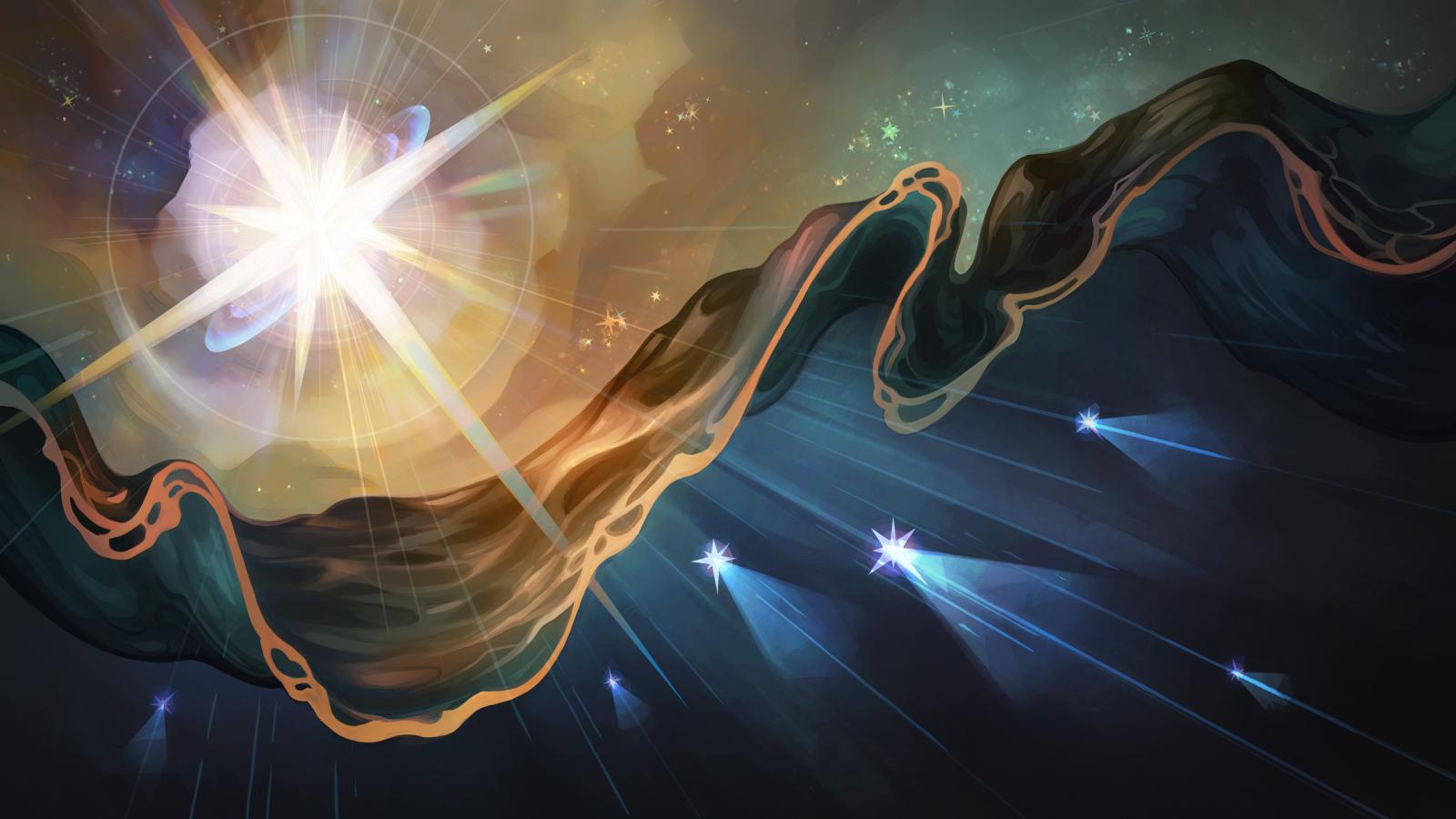Deep underwater, far off the coast of British Columbia, Canada, the world is cold and dark. Rising from the sand below bob a set of submerged buoys, securely fastened with mooring lines to the ocean floor. Tethered at intervals along each line are large glass spheres housing sensitive, light-detecting instruments.
The scientists who constructed these deep-sea instruments aren’t biologists or oceanographers. They’re physicists and astronomers. It’s here, 2 kilometers under the frigid Pacific waves, that they are hoping to capture wily, shape-shifting, nearly massless particles called neutrinos that could change our view of the universe.
Particle decays regularly produce mid-to-low-energy neutrinos, the kind that physicists spend the bulk of their time observing. But every once and a while a different kind of neutrino is detected—a high-energy cosmic neutrino.
Scientists know from the intense energy of these superpowered particles that they must have been accelerated by extreme objects outside our galaxy.
“These energies are really hard to imagine,” says Juan Pablo Yanez Garza, a physicist and assistant professor at the University of Alberta. “When you consider how we accelerate particles in our labs, like the Large Hadron Collider, and plug in the typical magnetic fields in the universe, you realize that you would need an ‘accelerator’ the size of an entire galaxy to energize neutrinos this much.”
Using gigantic, specialized detectors, scientists have just begun to pinpoint some of the extragalactic origins of these particles. Figuring out where high-energy neutrinos come from can help solve longstanding mysteries about the behemoth cosmic accelerators that produce them, resolve unanswered questions about cosmic rays, and even provide hints about the origins of dark matter.
The instruments in the Pacific Ocean are some of the first steps toward a proposed experiment called the Pacific Ocean Neutrino Experiment, or P-ONE, which scientists hope will help them uncover cosmic neutrino origins.
Cosmic messengers
Due to the vastness of space and the ubiquity of view-blocking dust clouds, most of the universe is hidden from photon-based telescopes. Instead, astronomers look for messenger particles, such as neutrinos, to learn more about these dark regions, which include some of the highest-powered objects in the universe. Neutrinos are ideal cosmic messengers. Their limited interactions with other particles and chargeless state mean they can race across space unencumbered by magnetic fields and dust clouds. However, this introversion means they can be hard to capture when they reach Earth.
Scientists have developed goliath detectors in hopes of upping the odds. Even so, the chance of catching a high-energy cosmic neutrino is slim. In its 12 years of operation, the IceCube detector—one of the premier cosmic neutrino observatories, located at the South Pole with a cubic kilometer of detection volume—has caught only a few hundred.
“With more than 10 years of data from IceCube, we still do not know what most of the cosmic high-energy neutrino sources are,” says Lisa Schumacher, a research scientist at the Technical University of Munich, who is involved with both IceCube and P-ONE.
But we do know about some of them. In 2018, the IceCube observatory was the first to pinpoint a source of high-energy neutrinos: a blazar 3.7 billion light years away. A blazar is the nucleus of a galaxy powered by a black hole that can accelerate particles in huge jets at nearly the speed of light. Then in 2022, IceCube announced a second source in another active galaxy just 47 million light years away, where scientists think neutrinos and other matter are accelerated around a giant black hole.
While active galaxies are now a confirmed source, statistical analyses show that they alone can’t account for all high-energy astrophysical neutrinos. “The problem is we need more data,” says Elisa Resconi, a professor at the Technical University of Munich who has worked with IceCube. “Statistics is what’s limiting us right now.”
A light in the dark
To gather more data, scientists like Resconi have been dreaming up new neutrino observatories. Resconi spearheaded an effort to launch the new large-scale P-ONE experiment. With a goal of building hundreds of neutrino detectors along several 1-kilometer-long lines, the experiment is intended to complement IceCube. From its location in the northeast Pacific, P-ONE could grab neutrinos from different parts of the universe that IceCube can’t see.
“The idea is to have a telescope that would be similar to IceCube, but with improvements given advances in technology over the last decade” Resconi says. “Our aim is to really complement other detectors, as we want to be able to work together and pool our data.”
P-ONE will detect neutrinos in the same way IceCube has for years—by looking for the tiny streaks of light neutrinos create as they bump into other particles in a medium such as water or ice.
To block out other atmospheric particles that can mimic these tiny streaks, scientists often install neutrino detectors underground. Some neutrino detectors, like the Sudbury Neutrino Observatory in Canada and Super-Kamiokande in Japan, are built in former or currently operating mines. Others, like the Baikal Deep Underwater Neutrino Telescope in Russia and the future Cubic Kilometre Neutrino Telescope off the coast of Italy and France, are built deep underwater. P-ONE scientists hope to add to—and widen the reach of—the aquatic fleet.
P-ONE’s location in water gives it an edge over IceCube, which is enshrined 2,000 meters deep in glacial ice. Though the Antarctic ice is highly transparent, its crystalline structure prevents a beam of light from traveling along a perfectly straight line. Since the angle and direction of the streaks are used to identify where in the sky the neutrino came from, this diffusion makes it harder for IceCube to identify cosmic neutrino factories.
“The total amount of light the detectors will measure with P-ONE will be a little bit less than IceCube, but we can better reconstruct where the light came from,” Schumacher says.
Neutrinos, bioluminescence, and more
Scientists have proposed to build P-ONE off the backbone of Ocean Networks Canada’s oceanographic observatory, the largest permanent oceanographic infrastructure in the world. If they do, P-ONE scientists will be able to tap into the network of hundreds of kilometers of optical cables and substations already installed on the ocean floor, saving the experiment time and money.
In return, P-ONE could also open new doors in oceanography and biology. Extra detectors, like hydrophones or oxygen sensors, could be attached to the P-ONE lines to measure the ocean’s vitals and conduct acoustic tomography, which uses low-frequency signals to measure ocean currents and temperature over large regions. And since P-ONE’s detectors are light-sensitive, they could also be used to study long-term changes in bioluminescence activity in the deep.
In 2018, the project scientists deployed STRAW-a, an instrument cluster designed to test the suitability of the site for the P-ONE experiment. Along with STRAW-b, which finished testing in 2021, the pathfinder mission proved the location’s clear waters would make a good canvas for neutrino detection. Now, the scientists are preparing for the next stage: installing a prototype instrument, planned for spring of 2024.
The prototype phase will see at least three lines, each with 20 detectors, installed on the ocean floor. This should allow scientists to capture 30 or so atmospheric neutrinos—enough to calibrate and provide proof-of-concept. If all goes well, P-ONE will eventually consist of 70 1,000-meter-long lines spread over a square kilometer of ocean. And if interest in the project grows, the experiment is extremely scalable.
“With P-ONE, IceCube and other detectors in the works, we can really do neutrino astronomy properly,” Resconi says. “We’ll be able to pinpoint many objects and do population studies, which can tell us which objects produce the most neutrinos.”







